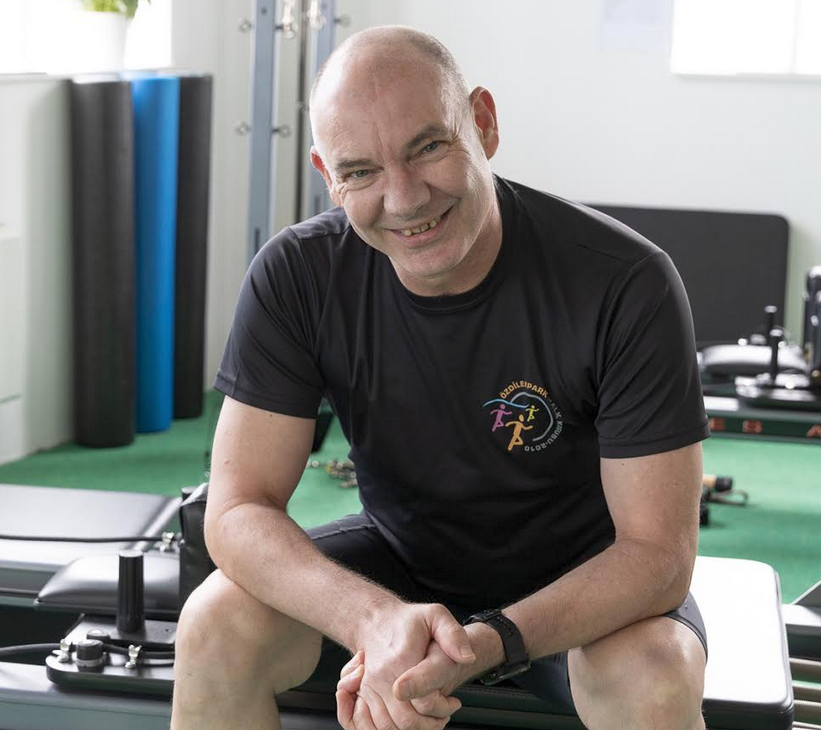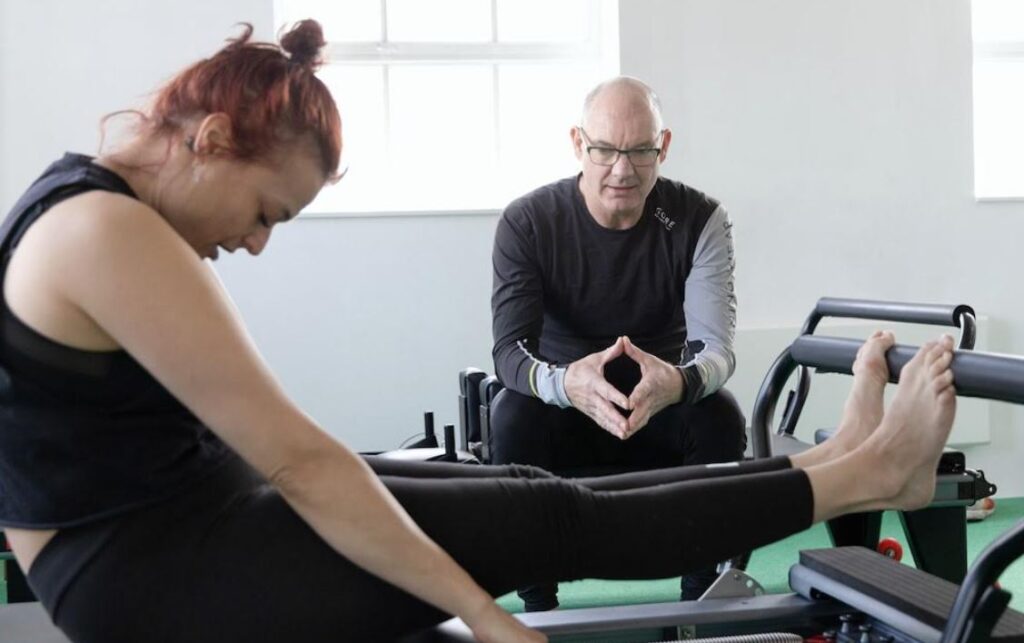Issue #368
Wednesday May 11, 2022
Pilates: More than Just the Exercises
by Miguel Bengoa
Before I became a Pilates teacher…
I was a language teacher. A very “learner focussed” teacher one:
- Students of language were “learners” learning skills, not studying “rules”.
- We studied what the learners brought in and produced. Not textbooks.
- The teacher was a facilitator for production of language – not a rule explainer.
- Teacher talk time was minimised to maximise learner production.
This article is about part of what I see as the “Concept” of Pilates.
I’ve outlined four “notions” that I’ve brought from language teaching and transferred them to Pilates. There are caveats and there is a place for those also.
First, becoming a Pilates teacher…
… took me years. I successfully did my Test Out and my NPCP certification… but something felt “wrong”.
- I felt I was trying to “fix” people, not teach them.
- There was no syllabus to teach from, but a body in front of me and hundreds of disconnected exercises to choose from.
- I was reinventing the wheel for each client.
- Tracking progress was really difficult. And what did progress actually mean in a Pilates context?
- I was microteaching small details and talking far too much. It was teacher focussed, not learner focussed.
But slowly, things started to change. My mentors encouraged me to look outside my training: “you don’t know what you don’t know”, they told me…
I checked new sources and, over time, I started having doubts about teacher training I had worked so hard towards.
It’s important to say here that I also discovered that the standard 500 hours of Comprehensive Training can only ever scratch the surface!
Then, one day, what I was suspecting and learning was confirmed by one little known and very inexpensive source!
The Pilates Pamphlet: “Return to Life through Contrology” (1957)
… is the sole source for this article. This is a reprinted and updated version of the original pamphlet (1957). Written by Frederick Rand Rogers and Joseph Pilates, it was given to new students of the studio and also at Jacob’s Pillow.
You can buy the pamphlet from Cathy Strack’s online store here: https://cathystrack.com/store/ .
My sincerest thanks to Cathy for permission to quote from the pamphlet and her generosity in forwarding me other archival sources.
The pamphlet is very inexpensive and, despite being only a few pages long, it clearly and unambiguously sets out how JP saw his work.
Notion #1
Pilates is education, not medicine or physical therapy
From the Pilates Pamphlet:
“(…) Contrology is not “medicine” or even “physical therapy”. For it’s aim is not specifically corrective but generally body-building and co-ordinating. Hence its users are neither “patients” nor “treated”. Each student is given as nearly as possible the same regimen (…)”
The italicised “student” is not mine but was written like that by Joe himself. Both “student” and “learn” are used ten times in just the few paragraphs that make up the pamphlet. Clearly, Joe saw Contrology as education.
So, if we are teaching “students”, the next question becomes “What are we teaching?”.
Notion #2
There’s a “Syllabus”
As soon as I saw the client as a student of Pilates, everything changed: I no longer had to keep reinventing the wheel. There was a direction. Lesson planning purgatory suddenly ended!
The answer to “what are we learning?” became astoundingly obvious: “Pilates”… ()
Now, I had to ask myself “what is Pilates?”!
“Pilates” is a surname so; I figure it has to be the exercises performed in a way that Joe Pilates (and others close to the source) might recognise: Mat & Reformer repertoire supplemented by the studio apparatus.
And, it also had to be practised on apparatus that he might also recognise:
“No medicine or other balls are used …”
“Nor is one given heavy weights to elevate… “
“… no high bar, parallel bars, horse, box, climbing rope, stall bar or Indian Club. Even the mats are significantly different from those found in other gymnasia.”
What I once thought of as “exercises” now became “evolutions”:
“Kindergarten movements – the “multiplication tables” of Contrology – learned, new evolutions are taught (…) the student progressing imperceptibly from elementary to higher (more complex…) movements…”
“Later, more difficult evolutions are learned.”
The idea of “evolving” through a syllabus blew my mind: from basic to more complex – just like language learning!
Notion #3:
Teachers are facil – itators, not instructors
I would grumble silently about being called a language instructor..
An instructor gives instructions and the trainee follows. In contrast, a language teacher teaches and the student learns production.
If you want to master a language, becoming an independent user of the target language has to be the overarching objective. The teacher needs to facilitate but it’s the student who has to produce.
A teacher is both an instructor AND a facilitator. Facile = easy, facile, simple, light, effortless, smooth, not demanding effort or involving difficulty.
I aim to teach Pilates, steering my students towards becoming independent practitioners. I want them to know what to do and when. I want them to know why they are doing what it is that they are doing. And I want all that to be easy.
Notion #4
Teacher Talk Time
Another concept from language teaching was “Teacher Talk Time”: if the teacher is constantly teaching, the learner never gets to practise production. If you can’t produce the language, you can’t claim proficiency.
Start with the basics. Later, we can fine tune & evolve.
Jay Grimes is reported to have said:
“Think like a sculptor: Get rid of the big chunks first. Don’t start with the eyelashes.”
I like to stand back, way back from the student, and shut up. And watch keenly.
Sometimes, I invite the student to become the teacher. This encourages the learner space to use their mind actively.
I ask concept checking questions rather than yes/no questions. Pilates becomes an intellectual challenge as well as physical.
The caveats
- It becomes more difficult to use the well-known marketing technique: find the specific problem that people have and address it. The objective now becomes to simply “learn Pilates”.
- By extension, you have to trust that what you are looking for is hard baked into The Method.
- You have to be prepared to not know things, until you do.
- You have to be prepared to let things go that once you thought were true.
- You have to be prepared to say: “that is just not accessible to me right now”.
- Finding connections between the exercises in the system becomes the driving force of teaching – so you have to practise Pilates. A lot!
So, what are the Practical Implications?
… coming soon!

Miguel Bengoa My Pilates journey is rather convoluted. I started in a gym in Turkey where I lived with a friend that had learned a few exercises. A modified Tic Toc with a Swiss Ball: (Corkscrew prep) was my first exercise. But I was hooked and found a BASI trained teacher. After a year of taking lessons three times weekly I decided that I wanted to become a teacher! I enrolled on my teacher training course with Balanced Body in Istanbul. I left Turkey and returned to the UK. And after 35 years away I certainly felt like a foreigner! The Pilates world was to prove so very different here too! Needing to find new teachers and a mentor, I got to know Lesley Logan online. Lesley introduced me to Julie Driver and I attended their workshop in London: a traditional teacher and a contemporary teacher working together and seamlessly teaching together – with one picking up from the other in the space of a breath… it was truly an amazing! I started lessons with Julie (still following Lesley online). I realised I was learning from both the Classical and Traditional and that’s when the lines started blurring. Julie encouraged me to have lessons with other teachers. I studied Sean Gallagher’s anatomy courses and those really helped me to see Pilates in a totally different light! My current Big Project is to create video and written tutorials of every Pilates exercise in the “standard” repertoire – now, that’s a Big One 🙂 Happy Pilatesing everyone!



